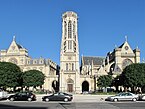Théodore Ballu
You can help expand this article with text translated from the corresponding article in French. (March 2011) Click [show] for important translation instructions.
|

Théodore Ballu (8 June 1817 – 22 May 1885) was a French architect who designed numerous public buildings in Paris . He is the grandfather of the industrialist and politician Guillaume Ballu.
Winning the Prix de Rome
In 1840, Théodore Ballu won the
The young laureate then left Paris and boarded at the
Architecture in Paris
Back in France, Théodore Ballu became an assistant to architect Franz Christian Gau on the Basilique Sainte-Clotilde construction site, then took charge after Gau's death in 1853.[2] From then on, his career was much focused on his preference for religious buildings.[3]
In 1860, he was named chief architect of Parisian buildings related to the religion. He then designed the Église de la Trinité (1861–1867), the Saint-Esprit temple on Rue Roquépine, and the churches of Saint-Ambroise (1863–1869) and Saint-Joseph (1866–1875).[3]
He also directed the
L’Eglise de la Trinité[3] is very emblematic of his work because it demonstrates his extensive knowledge of various architecture styles, his passion for eclecticism, which was very popular at the time, his tendency to incorporate numerous sculpted or painted decorations and his in-depth knowledge of cost-efficient construction. The Trinité area became the architect's favorite place, where he owned several properties and designed his home.
The Saint-Germain-l’Auxerrois belfry
From 1858 to 1863, Théodore Ballu designed and created the
-
Saint-Jacques Towercirca 1867, restored by Ballu between (1854–58)
-
The belfry ofSaint-Germain-l'Auxerrois(1858–63)
-
Église de la Sainte-Trinité, Paris(1861–67)
-
Église Saint-Ambroise, Paris (1863–69)
References
- ^ ISBN 978-0-19-860678-9.
- ISBN 0-14-051323-X.
- ^ a b c d Sturgis, Russell (1901). A Dictionary of Architecture and Building, Volume I. Macmillan. p. 195.
Bibliography
- Répertoire des architectes nés ou actifs dans les Vosges : 1800–1940, Épinal (2007), Archives départementales des Vosges, ISBN 978-2-86088-052-7
External links
- (in French) Drawings by Ballu, on ENSBA
- Musee-orsay
- Cosmovisions
- Paris Tourism: Tour Saint Jacques




